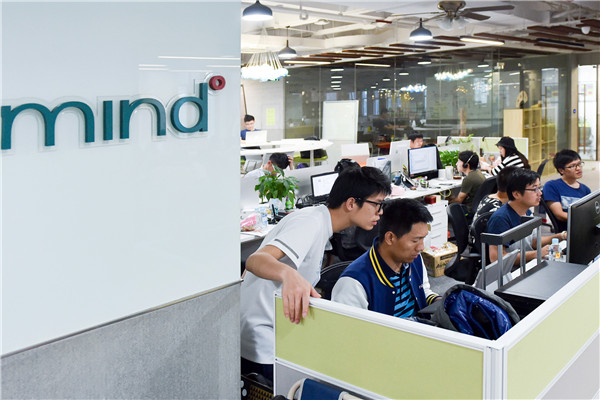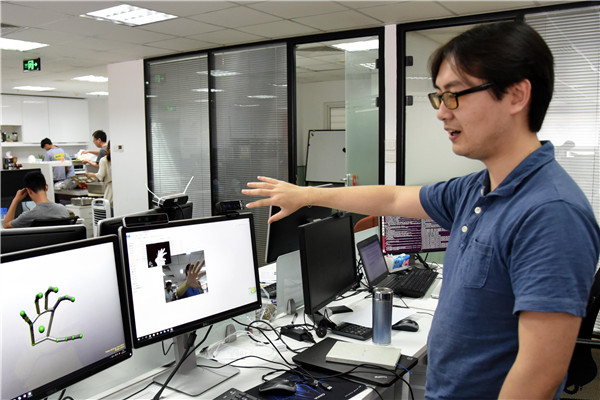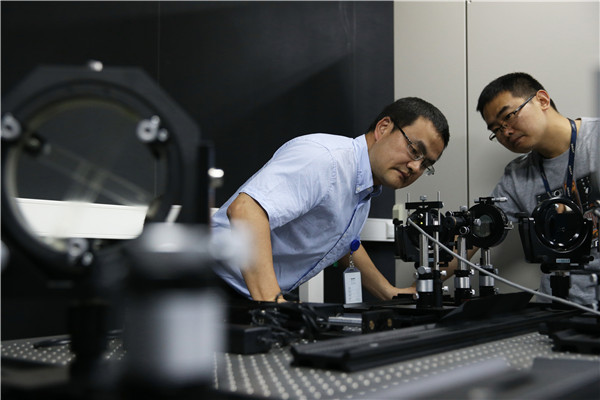
Staff members work at a startup company at Nanshan Science and Technology Park in Shenzhen, South China’s Guangdong province on May 25, 2016. [Photo/Xinhua]
High-tech zones in China have been gaining momentum and catching up with the “Silicon Valley” in the United States, underscoring the country’s innovation-driven development amid the economic “new normal”.
Statistics reveal the country’s all together 146 high-tech innovation zones contributed to 12 percent of the national GDP.
Beijing’s Haidian, Shanghai’s Zhangjiang and Shenzhen’s Nanshan, among others, are considered the most competitive tech zones vying for the future “Chinese Silicon Valley”.
Haidian in Beijing

A staff member presents how to use a gesture recognizer at SenseTime Group Limited in Zhongguancun high-tech innovation zone, Beijing on May 18, 2016. [Photo/Xinhua]
The northwestern district in Beijing, the origin of the technology hub Zhongguancun, was home to 6,157 high-tech enterprises - a tenth of the nation’s total- by the end of 2015.
In the first quarter of this year, as much as 33.4 startups on average were launched on daily basis. To date, the number of listed companies has reached 554.
Unicorn firms - startups valued at more than $1 billion - have reached 22 till date. For instance, Didi Chuxing, a popular online car-hailing company backed by Apple Inc, has become one of them after three years of growth.
“Haidian has become a place with the fastest-growing number of ‘unicorns’ worldwide,” said Wang Delu, head of Greatwall Strategy Consultants, adding that the “explosive growth” of innovative enterprises is a clear sign of the district rivaling the US Silicon Valley.
“The financial environment for startups in Haidian is even better than Silicon Valley, as it is drawing angel investment, venture capitals, and policy funds,” said Wang Wenjing, CEO of Yonyou Network.
Meng Jingwei, executive deputy director of Haidian, said the source of innovation in the district comes from an ecosystem that drives independent innovation and high-end industries.
Zhangjiang in Shanghai

Leng Yongbin (L) from Shanghai Synchrotron Radiation Facility makes experiment with his workmate at Zhangjiang high-tech innovation zone in Shanghai on May 27, 2016. [Photo/Xinhua]
Zhangjiang in East China was initially designed to be China’s “Silicon Valley” and “Drug Valley” upon its establishment in 1992. After two-decade development, Zhangjiang was listed as “the most competitive high-tech innovation zone to Silicon Valley” in the tech capital’s report in 2013.
Integrated circuit (IC), a key technology that made the whole IT industry and Silicon Valley, has long been dominated by a few multinationals as its development entails huge investment and top-notch know-how.
But Semiconductor Manufactory International Corporation (SMIC), a leading Chinese IC maker located in Zhangjiang, has made it a different story.
According to Gao Yonggang, its vice-president, the tech giant raked in $2.2 billion last year, ranking fourth by sales revenue in global IC manufacturing.
Meanwhile, as a “Drug Valley”, Zhangjiang has been dedicated to biological technology development as well, a growing path quite similar to Silicon Valley.
Statistics show the number of drugs under research has to date exceeded 300, half of which are innovative.
Yang Ye, director of Zhangjiang High-tech Industrial Park Administrative Committee, said Zhangjiang has been internationalized, and its development of talent and industries are competitive in the global arena.
He added the number of multinational R&D companies in Zhangjiang has reached 133 with a gathering of high-tech infrastructure facilities.
Nanshan in Shenzhen

A staff member presents a rollable keyboard at Nanshan Science and Technology Park in Shenzhen, South China’s Guangdong province on April 28, 2016. [Photo/Xinhua]
While people may still think of Silicon Valley when it comes to consumer-level unmanned aerial vehicles, China’s DJI Technology is emerging as the biggest drone maker in the world.
DJI, a startup based in Nanshan High-tech Industrial Park, has startled the world with its top-notch technologies in this field.
It produces 70 percent of world’s drone products.
DJI is just one of the many high-tech firms in Nanshan. The industrial zone in the southern Shenzhen city, covering merely 11.5 square kilometers while contributing 1.68 trillion yuan to Shenzhen’s GDP, has housed more than 7,000 enterprises.
Among those, nearly a thousand are high-tech firms and 84 are publicly traded companies. For example, Tencent Holdings, Huawei Technologies, and ZTE Corp are some of the big names worldwide.
Innovation a long way
Despite the achievements made by China’s high-tech zones, the gap remains between innovation development scale in China and the US.
“It’s true that the gap is narrowing... but in terms of innovation capability and strength, it may take decades for Chinese tech zones to catch up with the Silicon Valley,” said Li Yi, an overseas returnee who is trying to start his own business in China. “We are still dependent on the US in some core technologies such as operating systems and silicon chips.”
“Compared to the Silicon Valley, our capability in theoretical and foundation innovation is our first problem in the high-tech field,” said Ren Zhengfei, founder and president of Chinese telecom giant Huawei Technologies.
Other weak links, according to experts, are the lagging innovation of systems and mechanism that hinders technological innovation, and the lack of thorough protection of intellectual property rights that impedes the expansion of enterprises.
“Through consistent efforts, China’s high-tech zones stand a chance to catch up with international tech development,” said Zhai Lixin, Party secretary of the Torch High Technology Industry Development Center under the Ministry of Science and Technology.
Zhai said he is upbeat about the day when multiple high-tech innovation centers, or “Chinese Silicon Valleys”, emerge in the country.
